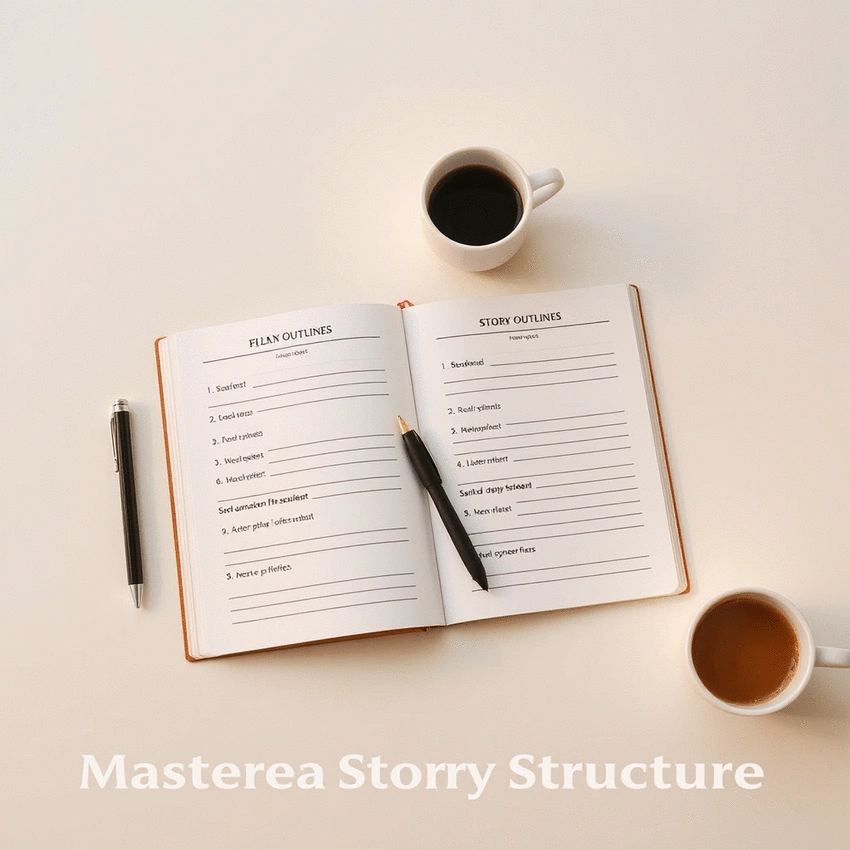Character Arcs Explained Simply
By Clara Eastwood / Nov 11
Have you ever felt overwhelmed by the complexities of storytelling? With a solid framework, you can transform that chaos into a clear and compelling narrative. Fill-in-the-blank templates are your keys to unlocking the creative process and ensuring your story resonates with readers.
Structured story frameworks offer numerous advantages for writers. Below are the key benefits represented visually.
Keep your ideas organized, making it easier to follow your plot.
With a template to guide you, you'll spend less time planning and more time writing.
Ensure that all elements of your story work together harmoniously.
Help authors build rich, compelling characters through structured arcs.
When it comes to storytelling, having a solid foundation is crucial. This is where fill-in-the-blank templates come into play! These structures simplify the writing process, offering a clear roadmap for writers to follow. By providing a framework, they help authors focus on the creative aspects without getting lost in the details. For more insights, consider using templates for fiction writing to streamline your creative process.
Using a fill-in-the-blank template allows writers to break down complex narratives into manageable parts. This approach can be incredibly helpful, especially for those just starting their writing journey. With my experience at Fiction Frameworks, I've seen how these templates can transform daunting ideas into structured stories filled with potential!
Many writers wonder if they really need a fill-in-the-blank template. The answer is a resounding yes! Here are several reasons why:
In my experience, many aspiring authors find these templates invaluable. They not only offer direction but also help to spark creativity when you're feeling stuck!
Structured story frameworks offer a multitude of advantages for writers at all levels. Some of the key benefits include:
At Fiction Frameworks, we believe that every writer deserves access to tools that simplify their creative process. By using a structured framework, you're not just telling a story; you're crafting a compelling narrative that resonates with readers! To learn more about how tools can enhance your writing, check out effective plotting tools for writers.
Now that we understand the importance of fill-in-the-blank story structures, let’s dive into how to construct your own! This process involves a series of steps that will guide you in developing your unique story.
The first step is to set the scene by identifying essential story components. This includes understanding who your protagonist and antagonist are as well as establishing the central conflict. By doing this, you lay the groundwork for a compelling narrative!
Did you know? Incorporating a theme into your fill-in-the-blank story structure can enhance the emotional impact of your narrative. Consider what message or feeling you want to convey and weave it through your characters' journeys. This will not only provide depth but also resonate more deeply with your readers!
Now that we've explored the intricacies of fill-in-the-blank story structures, let’s summarize the essential insights that can help you as an aspiring storyteller. Remember, using these templates can simplify your writing process and help you stay focused on your narrative goals. With the right guidance, you can navigate through the complexities of story development with clarity!
Here are some key takeaways to keep in mind:
By focusing on these takeaways, you’re better prepared to craft a compelling story that resonates with your readers. Take a moment to reflect on your own ideas and how these techniques can apply to your writing journey!
Are you ready to start crafting your story? You might feel excited and a bit nervous, but that’s completely natural! I encourage you to embrace this journey with open arms. At Fiction Frameworks, we believe that every writer has the potential to tell a great story—sometimes, you just need the right framework to get started. For those just beginning, starting your first novel together can be a great way to build confidence and structure.
Don't hesitate to utilize the resources available through Fiction Frameworks! Our fill-in-the-blank templates and story structure guides are designed to empower you as you write. Here are some of the resources you can dive into right away:
These tools can make a significant difference in your writing process, providing both structure and motivation. So, go ahead and get started!
As you embark on your writing adventure, consider these next steps:
For further reading, I recommend checking out resources on character development and plot pacing. These topics can deepen your understanding and enhance your storytelling skills as you progress. For a deeper dive into creating compelling characters, explore creating compelling character arcs.
Finally, here are some writing tools that I find beneficial for any fiction writer:
By incorporating these resources and following the steps outlined, you'll be well on your way to crafting a compelling narrative. Remember, at Fiction Frameworks, we’re here to support you every step of the way. Happy writing!
Here is a quick recap of the important points discussed in the article:

 Character Arcs Explained Simply
Every compelling story resonates with readers because of the evolution of its characters. Whether it
Character Arcs Explained Simply
Every compelling story resonates with readers because of the evolution of its characters. Whether it
 Outline Your Novel with Templates
Have you ever been stuck staring at a blank page, unsure of where to start? Outlining your novel can
Outline Your Novel with Templates
Have you ever been stuck staring at a blank page, unsure of where to start? Outlining your novel can
 Plotting Fiction: Strategies That Work
Did you know that a well-structured plot can make the difference between a reader putting your book
Plotting Fiction: Strategies That Work
Did you know that a well-structured plot can make the difference between a reader putting your book